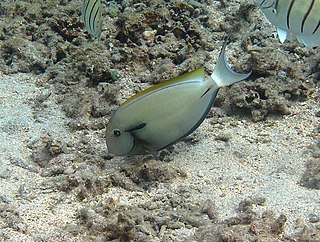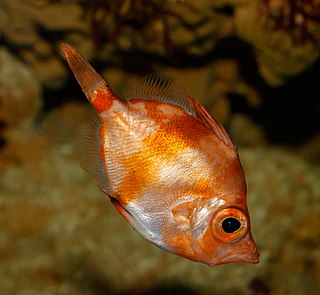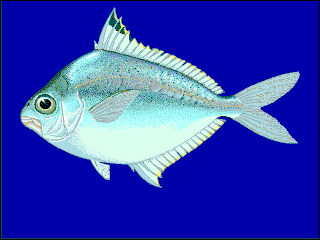
The school shark is a houndshark of the family Triakidae, and the only member of the genus Galeorhinus. Common names also include tope, tope shark, snapper shark, and soupfin shark. It is found worldwide in temperate seas at depths down to about 800 m (2,600 ft). It can grow to nearly 2 m long. It feeds both in midwater and near the seabed, and its reproduction is ovoviviparous. This shark is caught in fisheries for its flesh, its fins, and its liver, which has a very high vitamin A content. The IUCN has classified this species as critically endangered in its Red List of Threatened Species.

The spot-tail shark, or sorrah shark, is a species of requiem shark, in the family Carcharhinidae, found in the tropical Indo-West Pacific Ocean between latitudes 31°N and 31°S, from the surface to a depth around 72 m (236 ft). This shark grows to about 1.6 m. It is fished commercially over much of its range and the IUCN considers it to be near threatened.

The red porgy, or common seabream, is a species of marine ray-finned fish in the family Sparidae. It is found in shallow waters on either side of the Atlantic Ocean, being present on the western coast of Europe and the Mediterranean Sea as well as the eastern coasts of North and South America and the Caribbean Sea. It feeds on or near the seabed and most individuals start life as females and later change sex to males.

Acanthurus olivaceus, also known as the orange-band surgeonfish, the orange-shoulder surgeonfish or the orangebar tang, is a member of the family Acanthuridae, the surgeonfishes. It lives in the tropical waters of the Indo-west Pacific.

Zebrasoma scopas, the brown tang, twotone tang, scopas tang or brush-tail tang, is a marine reef tang in the fish family Acanthuridae. The brown tang is found throughout Oceania and is a herbivorous fish, feeding predominantly on filamentous algae. It is a highly popular fish in the aquarium trade.

Cantherhines dumerilii is a species of fish in the family Monacanthidae, the filefishes. Its common names include whitespotted filefish, barred filefish, orange-fin file, and yelloweye leatherjacket. It is distributed in the Indian and Pacific Oceans where it is found on coral reefs.

Acanthurus nigricauda, the epaulette surgeonfish, black-barred surgeonfish, eye-line surgeonfish, shoulderbar surgeonfish, white-tail surgeonfish or blackstreak surgeonfish, is a tropical fish in the family Acanthuridae. It is native to the Indo-Pacific region.

Stephanolepis hispidus, the planehead filefish, is a species of bony fish, a ray-finned fish in the family Monacanthidae.

Pomacanthus xanthometopon is a marine ray-finned fish, a marine angelfish belonging to the family Pomacanthidae found in shallow parts of the Indo-Pacific. It is commonly known as the blueface angelfish or the yellowface angelfish because of its striking facial colouration.
The West African bichir or retropinnis bichir, is a freshwater fish in the family Polypteridae, is found in the central Congo River basin and Ogooué River in Africa. It is a long, slender fish that grows to a maximum length of about 34 cm (13 in).

Zanclorhynchus spinifer, also known as the Antarctic horsefish or spiny horsefish, is a species of marine ray-finned fish belonging to the family Congiopodidae, the horsefishes or pigfishes. This fish is found in the Southern Ocean where it occurs at depths of from 5 to 400 metres. This species grows to a length of 40 centimetres (16 in) TL and is of minor importance to the commercial fishery industry.

The boarfish is a species of fish in the family Caproidae, the only known member of its genus. Its scientific name is from Greek κᾰ́προς (kapros) and Latin aper, both meaning "wild boar."

Eubleekeria splendens, common names splendid ponyfish and blacktip ponyfish, is a species of ponyfish.

Lethrinus erythracanthus, common names the orange-spotted emperor, orangefin emperor, and yellow-spotted emperor, is a species of emperor fish.

Genicanthus caudovittatus, the zebra angelfish, swallowtail angelfish, and lyretail angelfish, is a species of marine ray-finned fish, a marine angelfish belonging to the family Pomacanthidae. It is found in the Indian Ocean.

The whitespotted grouper, also known as the rankin cod, ocellated rockcod, small-spotted cod, white-spotted reef-cod or whitespotted rockcod, is a species of marine ray-finned fish, a grouper from the subfamily Epinephelinae which is part of the family Serranidae, which also includes the anthias and sea basses. It has an Indo-Pacific distribution. It is closely related to two other species of white spotted groupers in the genus Epinephelus.
The longfin lanternfish is a species of oceanodromous lanternfish that is oviparous, and a host of Sarcotretes scopeli.

Etelis carbunculus, the deep-water red snapper, ruby snapper or longtail snapper, is a species of ray-finned fish, a snapper belonging to the family Lutjanidae. It is found in the Indo-Pacific region.

Scopelogadus beanii, or Bean's bigscale, is a species of ridgehead fish. It is named for Tarleton Hoffman Bean.
Rabaulichthys altipinnis, the sailfin anthias, is a species of ray-finned fish within the family Serranidae. The species grows to a length of 6 centimeters, with 10 dorsal spines, 15 to 16 dorsal soft rays, 3 anal spines, and 6 to 7 anal soft rays. It is found in the western Pacific Ocean off of New Britain, Indonesia and Australia.

















